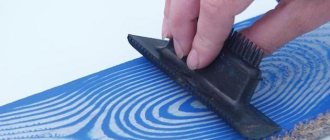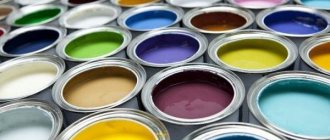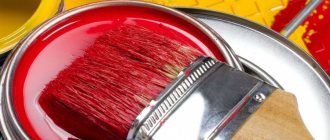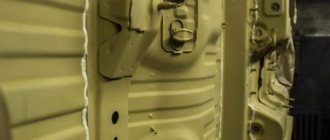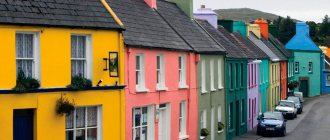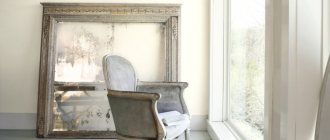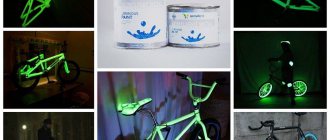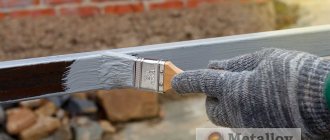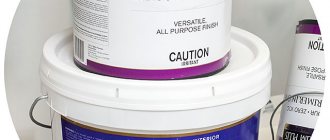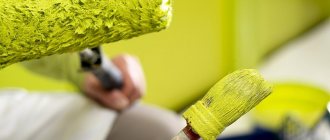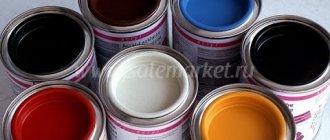What is chalk (slate) paint
Chalk paint belongs to the category of water-dispersible paint. It consists of a latex base, acrylic resins, modifying additives and filler (gypsum, marble chips, etc.). Due to the multiphase structure, the finished layer is matte and slightly rough. You can draw, write and take notes on it, and then wash off the chalk with a damp sponge without the risk of damaging the coating.
Chalk paint is a solution consisting of chalk and water, to which a certain amount of mineral additives has been added.
The latex base ensures water resistance and long life of the paint. Since solvents and toxic additives are not used during the work, the pigment does not irritate the eyes and respiratory tract during the drying process.
Chalkboard dye is used for finishing walls and furniture, restoring chalkboards, decorating souvenirs, etc.
The paint has good adhesion to plaster, wood, wallpaper, drywall, metal, plastic, ceramics and glass. When finishing objects upholstered with fabric, you can apply the dye to the entire surface at once, without resorting to special preparation methods.
In some sources you can find another name for this finishing material: graphite paint. It is not due to the composition of the product, but to the similarity of the coating to a slate board.
Features of the composition
The main feature of chalk dye is its long drying time. Primary curing of the finishing layer takes from 2 to 7 days.
The range of containers, palette and consumption rate depend on the manufacturer.
Color palette
Chalk dye can be monochrome (black, white, gray), tinted and transparent. The product to be tinted has a white base, which is highlighted by a bright pigment. When choosing a color, you should take into account that due to the matte texture, the surface turns out to be 20-30% paler than declared.
The palette of chalk paints for furniture includes many pastel shades: soft white, ivory, beige, cream, silky gray, brown, etc.
Packaging volume
The packaging of slate dye can have the following volume:
- 100-120 ml, 250 ml (for creating decor);
- 375 ml (for furniture and accessories);
- 300-350 ml (in cans);
- 0.5 l, 0.9 l, 1 l (for finishing walls, furniture, slates, etc.);
- 5 l (for room decoration).
Chinese manufacturers produce chalk aerosol in small cans - 80-100 ml. This product is suitable for one-time use: processing 1-2 souvenirs, decorating a car area, etc.
Some companies (Tikkurila, Krylon, Raduga) produce paint in only one volume - 0.9-1 liters. This is convenient when working with walls, furniture or boards, but significantly increases the cost of finishing small accessories. The most practical range of brands is Siberia and Blackboardpaint, which produce 3 types of containers: 500 ml, 1 l and 5 l.
Manufacturers offer various forms of chalk paint.
Consumption rate
Consumption depends on the following factors:
- Characteristics of the dye. The consumption rate is set by the manufacturer and indicated on the can or can. On average, 1 liter of dye is enough to finish 4-5.5 m². Some products are more economical and allow you to cover up to 9-10 m² of surface.
- Number and thickness of layers. According to the manufacturer's recommendations, colored paints are applied in 2-3 layers, and monochrome paints, especially liquid ones, are applied in 1-2 layers. Material costs will also depend on the relief and shade of the work area. Before covering with a light finish, it is advisable to putty the dark surface to reduce consumption. The thickness of the layer depends, first of all, on the experience of the master. Beginners often apply paint too thickly and leave uneven areas on a smooth surface. Defects have to be sanded down after each layer has dried.
- Method of application. The most economical tool is a spray gun. It sprays mini droplets of pigment, resulting in an even color and layer thickness. In addition, to work with the remote control you may need to slightly dilute the paint, which will further reduce consumption. The least practical method of application is with a brush. It should only be used on selected areas or small surface areas.
- Absorbency of the material. Smooth surfaces (metal, ceramics) do not absorb moisture well, so dye consumption will be small. Plastered concrete requires less finishing material than textiles or wood.
Drying time
Each layer takes 2-6 hours to dry. However, it will take much longer to completely dry the surface before painting. For example, Tikkurila dye dries for 6 hours, but finally hardens only after a week.
The leader in drying speed is an aerosol from Krylon (Chalkboard Paint). Complete curing of the finish takes only 1 day. However, this advantage is offset by the high price of the material: the cost of covering 1 m² is almost twice that of other paints.
Types, release form
Graphite dyes are produced in liquid form, packaged in metal cans and spray cans. Some manufacturers offer entire sets designed for various purposes. This can be paint plus a spray, a liquid transparent material plus several tinting agents, a slate composition plus a primer containing iron particles, with the help of which a magnetic layer is created, etc. The shelf life of paints is about two years.
Marker paint can be matte, glossy, or semi-matte. They draw on it with a special marker and erase the marks with a microfiber cloth. The cost of the material is 70-200 rubles, it is produced in containers of 500-1000 ml, the packaging is enough for 3 or more square meters. When sold as a set, it includes a clear varnish with a hardener, a cup, a stirring stick, an application roller, rubber gloves, and a tray.
Types of chalk dyes
To choose the right finishing material, you need to know what chalk paint is and what types of it exist on the market. Depending on the composition it can be:
- Chalk (slate). Suitable for drawing with crayons, resistant to abrasion and moisture. This paint is also used for furniture restoration.
- Magnetic slate. This coating allows you to attach small magnetic figures, photographs, notes and other lightweight objects to the surface of a board or wall. The dye contains small iron particles that close the field lines. Magnetic effect paint has a small palette: most manufacturers produce it in 3-5 shades. It can be black, green, blue, gray or brown. To change the color of the wall, cover it with 1 layer of chalk composition. Multi-layer finishing weakens the magnetic properties.
- Marker. Designed for drawing with water-based markers. Suitable for people with allergies to chalk dust and those who do not want to regularly remove traces of chalk from the floor. The coating is smoother and more durable, but takes longer to dry. In addition, the price of such a dye is higher than that of a classic slate dye.
Magnetic chalk paint has appeared on the market relatively recently.
Scope of application of the dye
Slate dye is used in the following areas:
- In teaching children. Having a whiteboard or drawing area on the wall allows you to develop useful skills, give your child daily tasks or review school assignments. By creating several slate surfaces in a preschooler's room, parents will be able to unleash his creative abilities and prevent damage to more vulnerable coatings (wallpaper, acrylic paint, panels). The presence of a slate zone becomes especially important during distance learning or home learning.
- In a home interior. Painting part of the wall with chalkboard paint will allow you to leave notes for family members, write down phone numbers, recipes or a shopping list. Most often, this technique is used to decorate a hallway or kitchen. In the second case, it should be taken into account that as the fat settles, it becomes more difficult to draw, and the surface itself acquires an unpleasant yellowish tint. If the writing board is located near the kitchen apron, it will have to be wiped regularly with a soapy sponge. It is not advisable to place the slate zone near wet areas (baths, sinks).
- For decoration of cafes, offices and other public places. Slate paint is often used to decorate the walls of pizzerias, youth cafes and bars. Menus are written on the chalk surface, thematic images are drawn, and promotional items are offered. Chalk or magnetic slate decoration of an office wall allows you to place important information on one surface, conduct a brainstorming session, leave a message to colleagues or take a break from the work routine.
- For restoration of furniture and household items. Matte paint allows you to artificially age the surface, completely covering the imperfections of the original coating. With the help of chalk pigment, old Soviet furniture or accessories (figurines, trays, picture frames, etc.) are often restored. If you paint several different decorations in the same color scheme, this will create the impression of a single ensemble. Restored furniture is suitable for design in country, Provence, vintage and shabby chic styles.
- For applying temporary designs to cars. Chalk dye can be used to create greeting signs, wedding decorations, banners and advertising images on cars. The pigment is washable, so it does not harm the car’s paintwork. Car wax is used to secure the designs.
- For creating homemade slate boards. A chalkboard is one of the most practical gifts you can make yourself. This accessory is suitable for a children's room, kitchen or work area (office, workshop). It can be placed on a special support or hung on the wall.
Despite its resistance to damage, moisture and UV rays, slate paint is used primarily for interior work.
Only certain brands are suitable for painting facades and exterior boards (for example, Krylon).
What to paint under the slate
Chalkboard paints can be used throughout the home:
- In the nursery. If you install a large board here or paint over an entire wall with chalkboard, children will have a place to create and learn. And the rest of the walls in the house will be completely safe.
- In the kitchen. Individual slate boards, kitchen aprons, and painted kitchen cabinet doors look very nice here. You can write down recipes, menus, reminders, shopping lists, and just declarations of love for each other on them.
Important! Some paints become discolored by hot grease, so they should not be applied near a stove.
A variety of materials can be painted to look like lead:
- wood, chipboard, MDF, fiberboard;
- metal;
- plaster;
- drywall;
- brick;
- glass;
- ceramics.
Dyeing technology
Chalkboard paint is very easy to use. Anyone can paint a wall or make a cute note board with their own hands.
The painting procedure is as follows:
- The surface to be painted should be cleaned of old coatings. If necessary, it is leveled with putty or sanded, and then washed to remove dust and dried.
- To ensure that the paint lies evenly, the surface underneath is primed and dried. Ideally, you should use a special primer for slate paints.
- To create a neat slate rectangle on the wall or refrigerator door, cover the surface around the perimeter with masking tape.
- The emulsion is mixed well and applied in several layers. Each layer must be completely dry before the next one is applied. Painting should be done in a ventilated area with an air temperature of +10°C and humidity up to 85%.
Advice! Slate paints harden quickly, so you need to work with them quickly.
You can wash the slate surface with soap or other household chemicals only a month after painting.
Advantages and disadvantages
The advantages of chalk dye are the following aspects:
- the composition is environmentally friendly and safe for humans;
- the coating is resistant to abrasion, water and some household products (soap, dish soap, neutral gels);
- the filler ensures the fire resistance of the layer, and the base provides its antiseptic and adhesive properties;
- There are no sharp or unpleasant odors during the drying process;
- chalk finish is suitable for all types of premises (high humidity may reduce the service life of the paint);
- slate coating adheres well to most materials and in most cases does not require special preparation;
- creating an impromptu board allows you to diversify the interior and get a convenient place for notes.
The disadvantages of the material include:
- high price of professional paint;
- vulnerability to low temperatures;
- long drying and curing;
- the need for preliminary plastering in the presence of potholes and other defects.
Surface preparation and painting
To work with paint and varnish materials you do not need special knowledge or expensive tools. You need to buy a standard painter's kit: paint container, roller, brush. Despite careful application, difficult-to-remove drops may remain on the floor, so the coating should be covered with cellophane. Window sills, frames, doorways are covered with paper tape.
As a surface preparation measure, you need to carefully level the wall. Separating pieces of putty must be removed, old wallpaper must be removed, although smooth canvases can be painted on top after preliminary priming. If the wall is old, the ideal option is to completely remove the coating layer, perform leveling according to the standard scheme, and only then paint. The last layer is always a high-quality primer (regular, for the corresponding surface).
Painting a wall is quite simple. It is important that there is no dirt or dust on the base that could settle after priming. You need to mix the paint in a jar and pour it into a small container. Using a dampened roller or brush, carefully spread the material over the wall surface. After 2 hours, you can apply the second layer, and you can use the surface (drawing) after 3 days.
If necessary, a day after application, magnetic priming is additionally done with a composition containing iron powder. During the first month of operation, it is allowed to wash the wall only with water, and after that it is permissible to use not too aggressive household chemicals.
How to use paint
When working with a chalk composition, you need to take into account the characteristics of the paint itself and its interaction with various types of materials. The surface must be smooth, dry and clean. Improper preparation of the working area and dye reduces the service life of the coating several times.
Before you start working with chalk paint, you need to carefully prepare the surface to be painted.
Preparing the dye for work
Preparing the paint consists of tinting it, diluting it to the desired consistency and pouring it into a container convenient for working with a roller or brush. According to the recommendations of manufacturers, the share of water should not exceed 10-15% of the amount of product.
Excess thinner increases the drying time of the layer, reduces its resistance to moisture and abrasion.
To make the coating durable, it is important to properly prepare the surface:
- clean the work area from dirt, dust and grease (in the latter case, treat it with a saturated soap solution, and then rinse with water several times);
- cover the floor with plastic film, newspapers or cellophane;
- if the work area is located near doors, windows or built-in furniture, cover the slopes, jambs or side walls with wide masking tape;
- sand the protrusions, cover potholes, cracks and irregularities with plaster;
- if the wall has not been painted previously, apply plaster, primer and putty, wait for the preliminary layer to dry completely;
- coat smooth surfaces (glass, metal, ceramics, etc.) with a primer intended for the selected material;
- When finishing a wall covered with wallpaper, you do not need to remove the previous layer; just wash the surface thoroughly and coat it with any acrylic primer (if there is a relief, the coating may require 1-2 more layers of dye than required according to the instructions).
During operation, the room temperature should be above +8...+10°C. Recommended air humidity is no more than 75-80%.
Suitable Tools
To apply the dye you will need:
- deep container for mixing the composition;
- wide tray for immersing tools;
- a roller with short or medium pile (for smooth surfaces it is recommended to use a velor one);
- brush (its width depends on the surface to be coated).
Some types of slate pigments can be applied with a spray gun.
Dyeing process
How to paint a surface:
- Limit the work area with construction tape. In most cases, slate paint is not used to cover the entire wall, but only the part of it that is intended for painting.
- Pour a small amount of paint into the tray. An important feature of the chalk product is its rapid drying. To prevent the dye from drying out during the process, you need to add it in small portions, stir periodically and close the jar immediately after pouring.
- Place the roller in the tray. Evenly paint the main part of the work area. It is recommended to paint hard-to-reach places (corners, joints) and areas near masking tape with a brush. During operation, you need to ensure that the roller remains wet. Drying will cause unevenness on the painted wall, separation of pile fragments and a decrease in the strength of the coating.
- Wait for the layer to dry. Repeat application 1-2 times depending on the manufacturer's recommendations.
Between applying layers you need to take a break of 2-3 hours. If the product packaging indicates drying time, it is recommended to follow the instructions. It will be possible to paint and wash the surface only after the layer has completely hardened and gained strength properties, which will happen in 1-7 days. For a homemade composition, you can use the average value: 3-4 days.
In the first month, fresh finishes can only be washed with clean water, without using soap or other aggressive agents.
When carrying out painting work, it is recommended to follow the manufacturer's instructions.
How to paint furniture with chalk paint:
- wipe the surface from dust; wood protected with varnish can be gently washed in warm water;
- dry the surface;
- To completely remove oil stains, wipe the work area with a degreaser (technical alcohol, solvent);
- if there are uneven spots or remnants of old paint, sand the wood and then remove the dust with a damp cloth or hairdryer;
- apply the first layer with a roller or brush (the choice of tool depends on the size of the area and the required smoothness of the coating);
- leave for 1-3 hours, and then level the dry surface with fine (soft) sanding paper;
- brush off dust with a hairdryer or a wide dry brush;
- repeat coloring;
- after the finishing layer has dried, decorate the surface;
- leave the finished product for 2-3 days.
The number of layers depends on the difference in the shade of the surface being painted and the pigment.
Finishing dark treated wood with light paint may require 4-6 coats of product. For small color differences, as well as for untreated wood, 2-3 applications are sufficient.
It is advisable to use soft chalk for drawing. The cheap material often used in schools often contains pebbles and sand, which increase wear and tear on the surface.
How to make such paintwork yourself
Often, the packaging in which the slate composition is sold is very large and a lot of excess material remains.
Often paint is available in cans or as a half-liter or liter spray, which are not cheap. If you need to paint a small area, you can make this material yourself.
First option
Take 250 grams of acrylic-based paint and cement in powder form, you will need 2 tablespoons of it. All this is mixed well, the required color is added and that’s it – the coloring agent is ready.
The only pity is that the product, based on cement powder, quickly loses its appearance due to scratches. To make the coating stronger, it is better to take marble chips, but they are harder to find.
For a shade, it is better to take something brighter, for example, blue, green, yellow.
Second option
In this case, you need to take 3 tablespoons of acrylic-based material (colored material), 1 tablespoon of varnish with a matte effect, a tablespoon of water and the same amount of putty on cement.
First, pour the cement mixture into the container, then the coloring material, varnish, mix everything well and dilute with water. Now you can use it.
Making your own chalk paint
The basic recipe for chalk paint involves mixing 2 components: latex or acrylic pigment with a dry filler - gypsum or tile grout. Some craftsmen use ground calcium carbonate (chalk) as a filler, but working with such a composition is much more difficult.
Main recommendations
There are several secrets in the process of preparing homemade dye:
- Acrylic and latex bases can only be diluted with water;
- the paint must be one-component, without primer and varnish;
- the base must be tinted before mixing with the filler;
- To create a contrasting pattern, you can apply paint of different colors in 2 layers, wiping them after drying with a soft sanding sponge and securing them with matte acrylic varnish.
For finishing walls and large surfaces, it is advisable to use a liquid composition, and for decorating accessories - a thicker one. Although complete drying will take about a day, you can sand, stick drawings and napkins on souvenirs 1-2 hours after painting.
Preparation of dye
You can prepare chalk dye using several recipes:
- Mix 2 parts latex paint and 1 part wall grout. The dry filler is first diluted with boiling water to a creamy state, and then cooled and combined with the base. If the dye contains calcium carbonate, as in ceiling compositions, the mixture may turn out loose and lumpy. To increase the durability of the coating, a small amount of acrylic varnish is added to it. This paint is not suitable for use on walls, but will decorate well wooden accessories or a small piece of furniture.
- Combine gypsum plaster and latex base. To create a finishing material, you must first dilute finely dispersed gypsum with water in a 1:1 ratio. The resulting mixture is added to latex dye in a ratio of 1:2 or 2:3. If you plan to cover a large area, it is advisable to test several proportions on small pieces of wood or wall, and then choose the most durable one.
- Mix 2-3 parts acrylic paint and 1 part diluted plaster. Acrylic-based dye is the most durable and functional. The proportion of components for it is the same as for the latex base in the previous recipe.
- Combine 1 cup of acrylic paint and 2-3 tbsp. cement, dolomite or marble chips. The finished layer will be durable and resistant to moisture, and the functional characteristics will depend on the size of the filler particles.
In the absence of gypsum plaster and grout, you can take 3-4 parts of latex dye and 2 parts of calcium carbonate.
Pros and cons of this tool
Modern materials have a large number of advantages, but they have very few disadvantages. Here are the main advantages of slate material:
- The coating turns out to be very durable, hardly wears out, is not erased, and is not afraid of mechanical influences.
- A good level of adhesion to many types of substrates, even if it is smooth (like glass), and this expands the scope of such paint.
- The coating does not shine, so it is convenient to write and make drawings on it, it is easy to wipe, and can be washed with plain water or special products.
- Fireproof, can't explode.
- It is environmentally friendly, so this coating can be used in children’s rooms, there is no smell.
- It is easy to work with this material, short drying time.
- Certain paints and varnishes contain an antiseptic, so they can be used even in rooms with high levels of moisture.
- This paint can cover the entire surface or only part of it.
- This covering allows children to fantasize and come up with original ideas; it can be made in any room of the house, even in the hallway.
- It has many functions: it can be used as a board, can be used as an apron in the kitchen, decorate a door or cabinet doors, and so on.
If the composition contains magnetic parts, then the finished coating will slightly slow down electromagnetic waves from equipment and electronics that you have at home. This can be considered both an advantage and a disadvantage (better for health, but Wi-Fi will be worse).
The disadvantages also include low temperature intolerance, so slate paint can only be used indoors.
Here are some other disadvantages:
- If you do not wipe the base, the stains on it will look very unsightly and spoil the overall appearance of the room.
- You may not like such a board, and you will have to do the finishing again.
- Typically, this type of paint has a dark tint, which can make the interior look moody.
- In a small room it is better not to use such paint, because it will look even smaller.
- Also, slate coating does not look good in many interiors, for example, in classic ones.
- If the base is uneven, then you won’t be able to create a board effect like in school; first you need to make the surface perfectly flat.
- The paint is so durable that if you get defects during application, they can be removed before it hardens, but then it won’t work.
- The cost of this substance is high - certain types have a price of about 8,000 rubles per 1 liter.
If someone has frequent allergies, then it is better not to use a chalk composition, but to pay attention to marker material, and also constantly wipe the board with a damp cloth. On a glass or aluminum surface, a specific primer mixture must be applied from the beginning to increase the level of adhesion.
The best manufacturers
The best manufacturers of chalk waterborne paint are Craft Premier, Siberia, Tikkurila, Rust Oleum, Magpaint and Benjamin Moore. Products from Magpaint, Siberia and Magnetico make it possible to impart magnetic properties to the coating.
Siberia
Siberia is a Russian brand of paints and varnishes. Marker, chalk and other types of paints are produced under it. They contain antiseptics, modifiers to increase strength and bright pigments.
The brand has the most favorable price-quality ratio.
Magnetico
Magnetico is a German manufacturer of special primers and dyes. The coating holds magnetic figures well and is abrasion resistant. The disadvantages are the cost and narrow palette.
Tikkurila
Tikkurila is a Finnish brand that is distinguished by a wide range of shades, high resistance and average finishing price. When applied correctly, the board or wall will withstand up to 5,000 painting and cleaning cycles.
Magpaint
The paint manufacturer Magpaint is located in the Netherlands. In addition to classic slate products, it produces marker and magnetic finishes. The finished layer withstands mechanical damage and washing well.
Craft Premier
Craft Premier is considered the leader among Russian paints in terms of abrasion resistance. According to the manufacturer, the coating can withstand 10,000 drawing cycles. To work with small objects and restore areas of slate, you can purchase brown or black pigment in a small jar.
Rust Oleum
American Rust Oleum paints are available in both liquid and aerosol form. The latter allows you to work with small souvenirs and hard-to-reach places on furniture and walls. The cost of painting with this product is higher than that of Russian and European brands.
Benjamin Moore Co
Benjamin Moore Co belongs to the premium segment of the market. This finish is resistant to damage and has a wide range of shades, but painting a large surface will not be cheap.
How to prepare a wall for painting
Preparing the wall for painting with a graphite composition is the same as for other similar types of finishing. First you need to completely remove the remnants of old coatings - wallpaper, paints, films, plasters. Afterwards, the surface is carefully leveled, a primer is applied, and the layer is carefully sanded. When applied to metal, wooden surfaces, products, they also need to be pre-primed.
If the old paintwork still holds up well, it is cleaned, degreased using household detergents, sanded until matte, and dust is removed. When you plan to paint not the entire wall, cabinet, table, but only a small part, the boundaries are created using masking tape.
The use of slate paint in the interior
Chalkboard-effect chalkboard paint is most often used to decorate children's rooms, kitchens and hallways.
Thanks to chalk paint, you can effectively update not only walls, but also furniture.
Children's room
Chalk paint can be used to finish all the main surfaces in a nursery: walls, furniture, accessories and even the ceiling. It can be used to restore scratched high chairs, work tables, headboards, etc.
For children's creativity and study, you can cover one of the walls or part of the wall near the desktop with slate composition.
If the chalk covering occupies a small area of the room, then it is advisable to choose a bright or contrasting color for it (black, green, dark blue, purple, pink, etc.). It is recommended to use pastel shades to decorate the entire room.
Kitchen and hallway
In the kitchen and hallway, the slate surface can be placed in the following areas:
- at the desk;
- around the kitchen apron;
- near the bar;
- between niches or built-in cabinets;
- on the sides of the front door;
- on the side of the window;
- above the dining table, etc.
When choosing a shade, you must take into account the color scheme of the design. In most cases, the notes area is painted in a dark, contrasting color: brown, dark green, black, graphite or gray.
